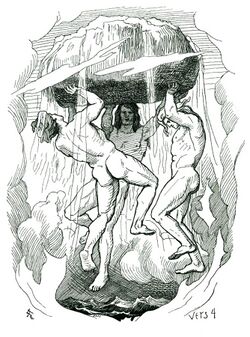Religion:Vili and Vé
In Norse mythology, Vili (/ˈvɪli/ VILL-ee; Old Norse: [ˈwile]) and Vé (/ˈveɪ/ VAY; O.N.: [ˈweː]) are the brothers of the god Odin (from Old Norse Óðinn), sons of Bestla, daughter of Bölþorn; and Borr, son of Búri.
Name
The Old Norse theonym Vé (or Véi) is cognate with Gothic weiha ('priest'), both stemming from Proto-Germanic *wīhōn, itself from the adjective *wīhaz, meaning 'holy' (cf. Goth. weihs, Old High German wīh).[1] A related noun, *wīhan ('sanctuary'), can also be reconstructed on the basis of Old Norse vé ('sanctuary'), Old English wēoh ('idol'), and Old Saxon wīh ('temple').[2][3]
Vili transparently means 'will' in Old Norse. It stems from the Proto-Germanic noun *weljōn ~ *weljan ('will, wish'; cf. Gothic wilja, Old English willa, and Old High German willo).[4][5]
Attestations
In Proto-Norse, the three brothers' names were alliterating, *Wōdinaz, Wiljô, Wīhaz),[6][failed verification] so that they can be taken as forming a triad of *wōdaz, wiljô, wīhą, approximately inspiration (transcendent, mantic or prophetic knowledge), cognition (will, desire, internal thought that leads to action) and numen (spiritual power residing in the external world, in sacred objects).[citation needed]
Vili and Vé, together with Óðinn, are portrayed the three brothers who slew Ymir — ending the primeval rule of the race of giants — and are the first of the Æsir. Of the three, Óðinn is the eldest, Vili the middle, and Vé the youngest. To the first human couple, Ask and Embla, Óðinn gave soul and life; Vili gave wit (intelligence) and sense of touch; and Vé gave countenance (appearance, facial expression), speech, hearing, and sight.
Compare to this the alliteration in a verse found in the Exeter Book, Wôden worhte weos "Woden wrought the sanctuaries" – where compared to the "triad" above, just the middle will etymon has been replaced by the work etymon. The name of such sanctuaries to Woden, Wôdenes weohas (Saxon Wôdanes wih, Norse Óðins vé) survives in toponymy as Odinsvi, Wodeneswegs.
While Vili and Vé are of little prominence in Norse mythology as attested; their brother Óðinn has a more celebrated role as the chief of the Norse pantheon. Óðinn remains at the head of a triad of the mightiest gods: Óðinn, Þórr, and Freyr. Óðinn is also styled Þriði "the third", in which case he appears by the side of Hárr and Jafnhárr (the "high" and the "even-high" or co-equal), as the "Third High". At other times, he is Tveggi "the second". In relation to the Óðinn-Vili-Vé triad, Grimm compares Old High German willa, which not only expressed voluntas, but also votum, impetus, spiritus, and the personification of Will, to Wela in Old English sources.[7] Keyser interprets the triad as "Spirit, Will and Holiness", postulating a kind of Germanic Trinity in Vili and Vé to be "blended together again in the all-embracing World-spirit – in Odin. [...] he alone is Al-father, from whom all the other superior, world-directing beings, the Æsir, are descended."[8]
According to Loki, in Lokasenna, Vili and Vé had an affair with Óðinn's wife, Frigg. This is taken by Grimm as reflecting the fundamental identity of the three brothers, so that Frigg might be considered the wife of either. According to this story Óðinn was abroad for a long time, and in his absence his brothers acted for him. It is worthy of note that Saxo Grammaticus also makes Óðinn (Latin: Othinus) travel to foreign lands and Mitoðinn[9] (Latin: Mithothyn) fill his place,[10] and therefore Mitoðinn's position throws light on that of Vili and Vé.[citation needed] But Saxo represents Óðinn as once more an exile, and puts Ullr (Latin: Ollerus) in his place.[11]
Chapter 3 of Heimskringla says While Odin was gone, Vili and Vé governed his realm. Once Odin was gone for so long that the Æsir believed that he would not return, Vili and Vé began to divvy up Odin's inheritance, "but his wife Frigg they shared between them. However, afterwards, Odin returned and took possession of his wife again".
See also
Notes
- ↑ Orel 2003, p. 466.
- ↑ Orel 2003, p. 465.
- ↑ Kroonen 2013, pp. 85–86.
- ↑ Orel 2003, p. 453.
- ↑ Kroonen 2013, pp. 578–579.
- ↑ Simek, Rudolf (1996) (in en). Dictionary of Northern Mythology (illustrated, reprint, revised ed.). D.S. Brewer. p. 362. ISBN 9780859915137. https://books.google.com/books?id=MZ24QgAACAAJ&q=Dictionary+of+Northern+Mythology. Retrieved 29 June 2015.
- ↑ Grimm, ch.7, 19
- ↑ R. Keyser (1847). "ch. 8". The Religion Of The Northmen (Nordmændenes Religionsforfatning I hedendommen). http://www.northvegr.org/lore/northmen/008.php. Retrieved 27 June 2009.
- ↑ "Erläuterungen zu den ersten neun Büchern der Dänischen Geschichte des Saxo Grammaticus Teil I Anhang" (in de). https://de.wikisource.org/wiki/Erl%C3%A4uterungen_zu_den_ersten_neun_B%C3%BCchern_der_D%C3%A4nischen_Geschichte_des_Saxo_Grammaticus_Teil_I_Anhang.
- ↑ "Saxo Grammaticus, Gesta Danorum, Liber 1, Caput 7" (in la). http://www2.kb.dk/elib/lit//dan/saxo/lat/or.dsr/1/7/index.htm.
- ↑ "Saxo Grammaticus, Gesta Danorum, Liber 3, Caput 4" (in la). http://www2.kb.dk/elib/lit//dan/saxo/lat/or.dsr/3/4/index.htm.
References
- Kroonen, Guus (2013). Etymological Dictionary of Proto-Germanic. Brill. ISBN 9789004183407.
- Orel, Vladimir E. (2003). A Handbook of Germanic Etymology. Brill. ISBN 978-90-04-12875-0. https://archive.org/details/handbookofgerman0000orel.
- Simek, Rudolf (1984). Lexikon der germanischen Mythologie. A. Kröner. ISBN 3-520-36801-3.
Further reading
- Grimm, Teutonic Mythology (1835), ch. 7, ch. 19.
- E. A. Philippson, Die Genealogie der Götter in Germanischer Religion, Mythologie und Theologie, Illinois studies in language and literature vol. 37, Urbana, Illinois (1953), 44–52.
 |


